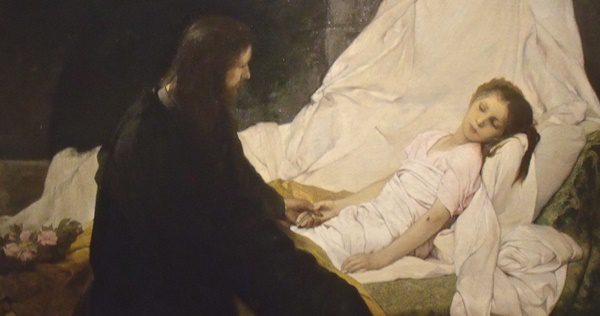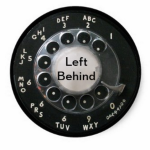Unity can be found in excluding and destroying or reconciling and healing. There is a huge abyss between the two.
-Rev. Tom Truby
Pastors have a frequent question when they begin to discover mimetic theory. “That’s great. But how does it preach?”
Reverend Tom Truby shows that mimetic theory is a powerful tool that enables pastors to preach the Gospel in a way that is meaningful and refreshing to the modern world. Each week, Teaching Nonviolent Atonement will highlight his sermons as examples of preaching the Gospel through mimetic theory.
Year B, Pentecost 6, Proper 8
July 1st, 2018
By Thomas L. Truby
Mark 5:21-43 (The Common English Bible, copyright 2011)
Was It the Bread of Life?
Our gospel begins with “Jesus crossed the lake again, and on the other side a large crowd gathered around him on shore.” He left to get away from a crowd. Now he is back and there they are.
I used to regard these large crowds as Jesus’ admirers and therefore benign. Now I see them as unpredictable and potentially dangerous. They are not crowds at the fair. They are highly charged crowds and volatile. Such crowds have a mind of their own, or more accurately, no mind at all. Terrible things have been done by large crowds.
But something surprising happens in this crowd. It moves in a positive direction. “Jairus, one of the synagogue leaders, came forward. When Jairus saw Jesus, he fell at his feet and pleaded with him, ‘My daughter is about to die. Please, come and place your hands on her so that she can be healed and live.’” Jairus steps out of the crowd and pleads from his heart.
After Jairus steps out everyone in the crowd is now concerned for the dying daughter and hoping Jesus will go. They are all for the one who is in trouble. The crowd now has a positive focus. The danger of turning into a mob has passed. They’re for human healing rather than finding identity through exclusion.
Unity can be found in excluding and destroying or reconciling and healing. There is a huge abyss between the two. Jesus wants us to unite in being for those whose life is threatened; whether a person, a subgroup different from the rest, or a whole race.
When the leader out of love for his twelve-year-old daughter makes his request, Jesus immediately “went with him.” Jairus, acknowledging his dependence, asks for help. His dependence leads to his independence as he becomes the one leading Jesus to his daughter. When we take leadership from the heart and dare ask for what we want, Jesus responds.
They aren’t alone as they move toward the dying daughter. “A swarm of people were following Jesus crowding in on him.” A dangerous feel returns to the narrative. Wasps swarm and people crowding too close make us feel claustrophobic.
In the midst of the crowd a woman who has been bleeding internally for twelve years waits to touch Jesus hoping to be healed. She has been to many doctors and spent all her money but the bleeding has gotten worse. Her suffering is secret and shameful. According to Jewish law she is unclean and shouldn’t be in the crowd at all lest they touch her. She is poor, alone and on the outer edge but she pushes to the center.
“Because she had heard about Jesus, she came up behind him in the crowd and touched his clothes. She was thinking, If I can just touch his clothes, I’ll be healed. Her bleeding stopped immediately, and she sensed in her body that her illness had been healed. At that very moment, Jesus recognized that power had gone out of him. He turned around in the crowd and said, ‘who touched my clothes?’”
In a sense she is a poor woman caught in the act of stealing power from the powerful. Do I read Jesus’ inquiry as a demand for full disclosure on who took power from him or should I read it more softly as coming from a place of love and gentleness; a request for information?
His disciples respond with a quizzical look and sharp tongues. “Don’t you see the crowd is pressing against you? Yet you ask, ‘Who touched me?’ But Jesus looked around carefully to see who had done it.”
The word “carefully” suggests Jesus wants to know who drew power from him not because his power meter had just surged but because he wants to know who is in trouble. He cares about the person into whom power has surged. He is not monitoring power, he is expressing love.
The woman also experienced Jesus’ question as accusing. Her feeling is colored by her experience in the world where she finds herself pushed to the bottom and stripped of all power. In the world people always monitor power and no one gives it away freely. There are always strings attached and quid-pro-quos expected. Jesus will have to bless her before she will know in her heart that she is a loved child of God.
“The woman, full of fear and trembling, came forward. Knowing what had happened to her she fell down in front of Jesus and told him the whole truth.” She is full of fear and trembling not because of Jesus but because of the crowd who may turn on her, particularly since she has been “outed”.
Her falling down was unnecessary. She had lived in the kingdom of humans governed by Caesars, hierarchy and fear but the one who stood before her was from another kingdom. His kingdom operated out of a different system of governance that saw all as worthy of love and respect. “Impure women” operating illegally in crowds had as much value as the “special daughter” of the Synagogue leader.
With the woman kneeling before him, Jesus says, “Daughter, your faith has healed you.” A daughter doesn’t have to kneel before someone who loves her. Fathers want their daughters to stand tall. That’s why Jesus had insisted that the woman declare herself. He wanted her to claim her place as a daughter. He wanted her to feel God loved her, sees her as part of the community and this had been true for all time, particularly the last twelve difficult years.
“Your faith has healed you,” he said. “Go in peace, healed from your disease.” Her faith in this case was her willingness to ignore her culture’s rules of exclusion and touch Jesus as though she were “legal”. The power Jesus felt leaving him was the positive power of inclusion as she claimed her rightful place as a daughter of God. Jesus’ web of relationships expanded, and she was included.
“While Jesus was still speaking with her, messengers came from the synagogue leader’s house, saying to Jairus, ‘Your daughter has died. Why bother the teacher any longer?”
The action now moves from the penniless woman twelve years ostracized, to the daughter of the synagogue’s leader who has just died at the age of twelve. Is St. Mark suggesting that until the least and overlooked are included and treated as daughters, the whole culture is sick and dying? Is he saying to heal the elite you must first heal the ignored, the hidden and the excluded? Could this be the meaning of this story within a story? Even the children of the elite can find healing by seeking out and helping those who have been left out.
“They came to the synagogue leader’s house, and he saw a commotion, with people crying and wailing loudly. He went in and said to them, ‘What’s all this commotion and crying about? The child isn’t dead. She is only sleeping.’”
The mourners laugh at him. It’s a bitter laugh. They think death is final and supreme. Not even Jesus has authority over death. “He threw them all out.” I think he is announcing the reign of death has come to an end, replaced by the kingdom of God?
Only the child’s parents, his disciples and Jesus remain in the room with the child. “Taking her hand, (something forbidden for Jews, since she is dead) he said to her, ‘Talitha Koum,’ which means, “Young woman, get up.” Suddenly the young woman got up and began to walk around.”
“They were shocked! He gave them strict orders that no one should know what had happened.” Why did Jesus impose his gag order? Maybe he didn’t want people to misunderstand his power. They would think power is the capacity to impose your will. They would miss that real power is driven by love. Until they see Jesus’ love demonstrated in the crucifixion and resurrection, they can’t possibly understand the power born of love. Best keep it under wraps for now!
“He told them to give her something to eat.” He knew how to touch a growing twelve-year old’s heart. You offer food. Was it the bread of life? I think so. Amen.
Image: Gabriel Max, La Résurrection de la fille de Jaïre (1878), Wikimedia Commons.
Stay in the loop! Like Teaching Nonviolent Atonement on Facebook!












